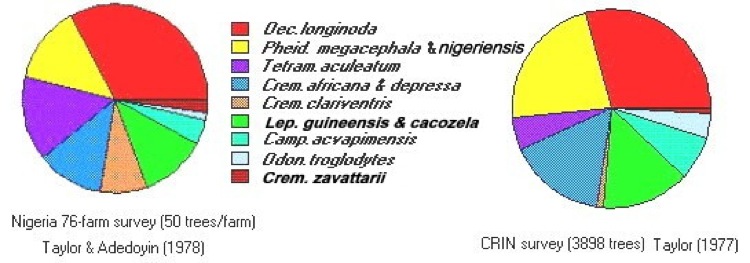Summary of the more common ant mosaic situations in West Africa
| The Ants of
Africa Summary of the more common ant mosaic situations in West Africa |
|
| Return to Mosaics Conclusions | Chapter 5 - More on Niches |
Clickable image with links to species - note - the names are as used in the original studies - the links are to the now probable names

The strata occupied by the various species are indicated by the positioning of the ellipses for arboreal dominants and the arrow tips for other species. Co-dominants and sub-dominants are shown in black lettering.

The pie charts show the relative abundance of the dominants in Nigerian cocoa (derived from Taylor, 1977, and Taylor & Adedoyin, 1978).
Of the other common species, the frequencies found in the 76-farm survey were Plagiolepis brunni - 7.4%, Crematogaster bequaerti/painei - 4.7%, Cataulacus guineensis - 3.6%, Camponotus vividus - 2.2%, Camponotus haereticus - 1.5%, and Tetraponera anthracina - 1.5%. The last-named has a distinctive life-style and simply appears able to fit a niche unaffected by dominants.
The situation in Ghana seems likely to be little different, apart from the presence of Crematogaster striatula in areas adjoining secondary forest (see Majer, 1972). The mosaic on forest trees may well be the same, especially on sub-storey trees, factors such as the form of leaves, rot holes etc., will determine the availability of nest sites and hence the most likely dominant to be present.
Development of the ant mosaicThe combined analyses enabled the development of a description
of how the changing habitat presented by a cocoa plantation - as it
passes from saplings, with an unclosed canopy; through maturity, with a
closed interlocked canopy; into the final stage, of ageing and canopy
degradation - profoundly affects the potential occupancy by the main
species of dominant ants. The main extraneous factor was the presence of the indigenous shade trees which were obligate nesting sites for Crematogaster africana and Crematogaster depressa (presumably why they were not found at over half the 76 farms). Interestingly, Camponotus acvapimensis usually is described as a savannah species but its frequency was rather higher in the wetter, eastern, area of the 76-farm survey. |
|
©1998, 2003, 2004, 2007, 2011 - Brian Taylor CBiol FSB
FRES 11, Grazingfield, Wilford, Nottingham, NG11 7FN, U.K. |